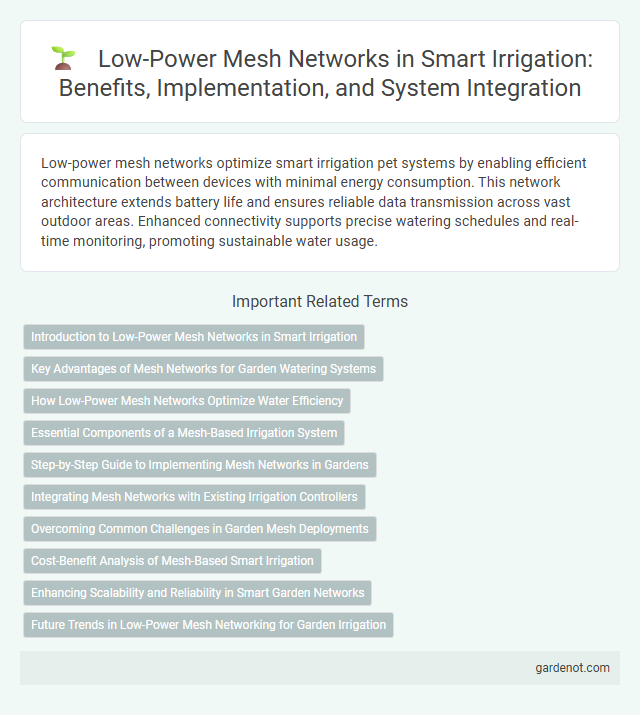Low-power mesh networks optimize smart irrigation pet systems by enabling efficient communication between devices with minimal energy consumption. This network architecture extends battery life and ensures reliable data transmission across vast outdoor areas. Enhanced connectivity supports precise watering schedules and real-time monitoring, promoting sustainable water usage.
Introduction to Low-Power Mesh Networks in Smart Irrigation
Low-power mesh networks enable efficient communication among distributed sensors and controllers in smart irrigation systems by minimizing energy consumption while maintaining reliable connectivity. These networks use low-power wireless protocols like Zigbee or Thread to create self-healing, scalable topologies that optimize water management through real-time data sharing. By leveraging mesh networking, smart irrigation systems achieve extended battery life and robust coverage, crucial for large agricultural fields and remote installations.
Key Advantages of Mesh Networks for Garden Watering Systems
Low-power mesh networks enhance garden watering systems by enabling seamless communication between multiple irrigation nodes, ensuring reliable water distribution across diverse plant zones. Their self-healing capabilities reduce maintenance needs and prevent system failures, maintaining consistent moisture levels essential for plant health. Energy-efficient operation extends battery life, supporting sustainable and cost-effective smart irrigation solutions.
How Low-Power Mesh Networks Optimize Water Efficiency
Low-power mesh networks optimize water efficiency by enabling precise, real-time communication between soil moisture sensors, weather stations, and irrigation controllers across large agricultural fields. These networks reduce energy consumption through efficient data routing and low-latency signaling, ensuring timely irrigation adjustments that minimize water waste. By integrating distributed sensor data, low-power mesh systems facilitate adaptive irrigation schedules tailored to microclimate variations, significantly conserving water resources.
Essential Components of a Mesh-Based Irrigation System
A low-power mesh network in smart irrigation systems relies on essential components such as battery-efficient sensor nodes, wireless communication modules, and edge computing units to optimize water distribution. Each sensor node collects soil moisture, humidity, and temperature data, transmitting it through multi-hop pathways to central controllers for real-time analysis. These components ensure scalable, reliable connectivity while minimizing energy consumption, enabling precise irrigation management and substantial water savings.
Step-by-Step Guide to Implementing Mesh Networks in Gardens
Implementing a low-power mesh network in gardens involves selecting energy-efficient wireless nodes like Zigbee or LoRa modules to ensure extended battery life for smart irrigation systems. Position each node strategically to maximize signal coverage and create robust communication pathways, allowing sensors and controllers to relay data seamlessly across the garden. Configure network protocols for self-healing capabilities and minimal latency to optimize water usage based on real-time soil moisture data and environmental factors.
Integrating Mesh Networks with Existing Irrigation Controllers
Integrating low-power mesh networks with existing irrigation controllers enhances system efficiency by enabling seamless communication between devices without significant energy consumption. These networks extend connectivity across large agricultural fields, allowing precise control and monitoring of water usage in real time. Compatibility with legacy controllers ensures cost-effective upgrades while maintaining reliable irrigation schedules and reducing water waste.
Overcoming Common Challenges in Garden Mesh Deployments
Low-power mesh networks in smart irrigation systems enhance garden automation by optimizing energy consumption while maintaining reliable connectivity across diverse plant zones. Techniques such as adaptive routing, signal amplification, and interference mitigation address obstacles like signal attenuation, network congestion, and environmental interference. Integrating these solutions ensures efficient water management, extends device battery life, and supports scalable garden mesh deployments.
Cost-Benefit Analysis of Mesh-Based Smart Irrigation
Low-power mesh networks in smart irrigation systems significantly reduce operational costs by enabling energy-efficient sensor communication and minimizing maintenance requirements. The decentralized mesh topology ensures robust coverage across extensive agricultural fields, enhancing irrigation precision and water conservation. Cost-benefit analysis reveals that initial investments in mesh-based infrastructure are offset by long-term savings from reduced water usage and improved crop yields.
Enhancing Scalability and Reliability in Smart Garden Networks
Low-power mesh networks significantly enhance scalability and reliability in smart garden irrigation by enabling seamless communication between multiple sensor nodes and controllers across large areas. These networks reduce energy consumption through optimized routing protocols, ensuring prolonged device operation and consistent data flow for precise water management. By supporting self-healing and adaptive connectivity, low-power mesh networks maintain robust system performance despite environmental challenges or node failures.
Future Trends in Low-Power Mesh Networking for Garden Irrigation
Advancements in low-power mesh networking are revolutionizing smart garden irrigation by enabling more efficient and reliable communication between sensors and controllers with minimal energy consumption. Future trends emphasize integration of AI-driven analytics and adaptive routing protocols to optimize water distribution based on real-time soil moisture and weather data. Enhanced battery technologies and energy harvesting methods will further extend node lifespan, reducing maintenance and promoting sustainable irrigation practices.
Low-power mesh network Infographic

 gardenot.com
gardenot.com